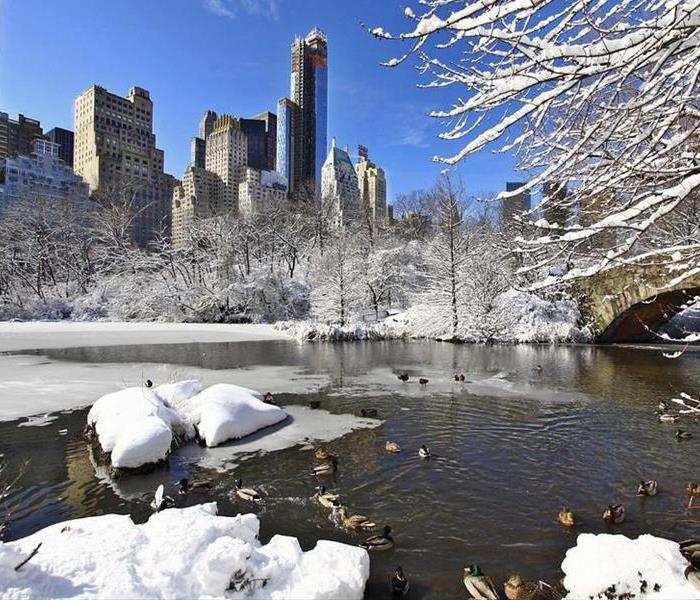SERVPRO of Great Neck Port Washington presents Commercial Client Checklist for Weathering Winter
3/3/2014 (Permalink)
The thaw may be on in some areas, but winter isn't over yet. Prepare yourself with this checklist.
By BOB KHOSROPUR
Note: Bob Khosropur is senior vice president of Mariposa Insurance Services
The polar vortex is an anomalous weather event that can be as devastating as more common natural catastrophes. The Insurance Services Office (ISO) is assigning catastrophe numbers to these events, and the events themselves are causing billions of dollars in commercial property damage. Even if we don’t give the cold a name or a number, cold snaps can bring businesses to their knees.
This year has started out with some exceptionally cold weather, especially in southern states which are not accustomed to prolonged winter weather conditions. The concept of “reasonable care” included in many insurance policies to prevent damage from cold weather has traditionally been interpreted differently in, for example, Florida versus Minnesota. But this year’s extreme conditions are making the meaning have a more equal definition for the whole mainland.
Commercial property comes in many sizes and shapes, with one common feature: they exist to turn a profit. When the property cannot fully function due to a loss, the cares of repair and downtime begin to become the owners’/managers’ new job.
Commercial property ranges from large offices or manufacturing facilities to small duplex rental properties. Whatever the type or size, some of the most commonly experienced damage from severe and sustained cold, snow and ice arises from:
• Freezing and bursting pipes, resulting in water damage to property, records, etc.
•Frozen sprinkler pipes, which can flood rooms and malfunction during a fire
• Inaccessible fire hydrants
• Water or temperature change damaging contents and inventory
• Collapse or partial collapse of roofs due to the weight of snow or ice
• Wind damage to roofs and buildings from fallen trees, branches or flying debris
•Ice damming, which can cause interior water damage
• Loss of revenue (business interruption)
• Injury to guests and employees.
A little preventative action can save your commercial property clients much time and money.
Useful tips to share with your clients to help prevent problems related to harsh winter weather.
• Maintain heat to no less than 45 degrees Fahrenheit throughout unoccupied facilities, including attics and basements. Setting thermometers in various rooms will give you an idea of problem areas which may require additional heat or insulation
• Ensure adequate fuel for your heating system (oil, gas, electric power, backup).
• Sign up for inexpensive systems that alert you via text messaging when the building’s temperature has dropped below a set value. This can help you take immediate action to protect the property, e.g. repair a breach in the building, utilize emergency generators, etc.
•Conduct an annual fall inspection of the shell of your building to ensure there are no gaps letting in the weather.
•Understand how your sprinkler system works and take precautions to drain it, if applicable (dry-pipe style). For wet-pipe systems, ensure that the room heat is adequate, or use heat tape to ensure their warmth.
• Drain the water from all systems and equipment that is not needed in the winter, such as air conditioning units.
•Inspect your roof every year before winter and ensure that it is well sealed, and sheds/drains water properly; gutter and downspout maintenance is a must.
• Remove any branches or trees that can come into contact with the building when heavily laden with ice and snow. Consider having experts remove heavy snow accumulation from your roof(s) as needed to reduce the chance of collapse.
In the event of a loss:
•Contact your agent as soon as possible and explain any emergency action you have taken, or need to take to prevent further damage to the property. They can assist with their knowledge of emergency mitigation vendors.
•Learn how your deductible works early on in the process, especially if you have multiple properties under a single policy.
• Be thorough with the adjuster in showing all the damage and provide documents pertaining to any business interruption claim you may make.
• Keep all receipts and invoices for any emergency or temporary repairs made, and provide this information to the adjuster. Keep records of work you or your staff have done to protect the property from further damage.
• Understand that a "Reservation of Rights," "Non-Waiver Agreement" and "Proof of Loss" are legal documents issued by your carrier, which are necessary to protect your rights and benefits every bit as much as they protect the carrier’s.




 24/7 Emergency Service
24/7 Emergency Service
